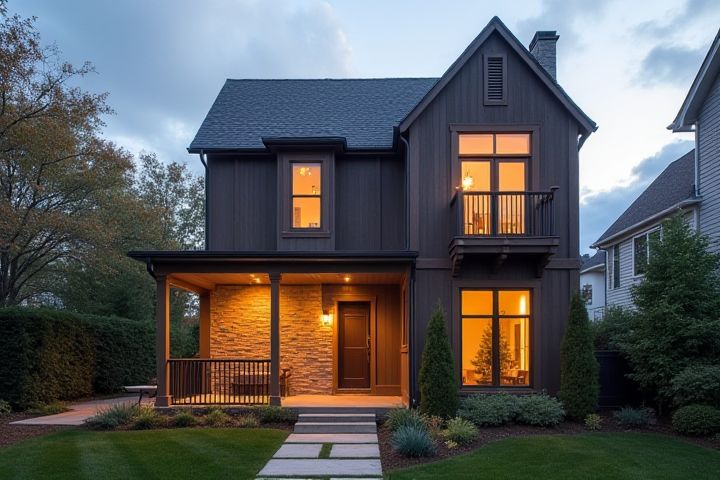
A house can indeed become a smart home through the integration of various technologies that automate and optimize daily activities. Smart devices like thermostats, lighting systems, security cameras, and appliances connect to a central hub or your smartphone, allowing remote access and control. Advanced home automation systems can learn your preferences, adjusting energy use to enhance efficiency while reducing utility costs. Voice-activated assistants, such as Amazon Alexa or Google Assistant, provide convenient hands-free control over these connected devices. By incorporating smart features, your home can improve comfort, security, and energy management significantly.
Can A House Be A Smart Home
Internet connectivity is essential.
A smart home relies heavily on robust Internet connectivity, which enables seamless communication between various devices. High-speed broadband, ideally ranging from 100 Mbps to 1 Gbps, is crucial for optimal performance, allowing you to control smart appliances, security systems, and lighting remotely. Devices like smart thermostats, security cameras, and voice assistants communicate through Wi-Fi, requiring a stable connection to function effectively. Investing in a mesh Wi-Fi system can enhance coverage throughout your home, ensuring that every room remains connected to the Internet for an integrated smart living experience.
Integration of IoT devices.
A smart home integrates various Internet of Things (IoT) devices, allowing for seamless communication and automation within your living space. For instance, you can control lights, thermostats, and security cameras from a single smartphone app, enhancing convenience and energy efficiency. With over 30 billion IoT devices projected to be in use by 2025, the potential for enhanced monitoring and control in your home is immense. This interconnected ecosystem not only simplifies daily routines but also contributes to increased safety and optimized energy consumption.
Requires a central hub or control system.
A smart home requires a central hub, which acts as the command center for managing devices and systems. This hub, often compatible with various smart technologies, allows you to control lighting, heating, security, and entertainment from a single interface. Many popular hubs, such as Samsung SmartThings or Amazon Echo Plus, support multiple protocols like Zigbee and Z-Wave, ensuring seamless communication between devices. To fully realize a smart home experience, consider configuring your hub to automate tasks, enhancing convenience and energy efficiency throughout your living space.
Smart lighting options available.
Smart lighting options can transform your house into a fully integrated smart home. With technologies such as LED bulbs, your energy consumption can be reduced by up to 80% compared to traditional incandescent lighting. Systems like Philips Hue or LIFX allow for customizable color settings and scheduling, enabling you to program lights to turn on or off at specific times for added security. Control options range from smartphone apps to voice-activated assistants like Amazon Alexa or Google Assistant, giving you the convenience to manage your lighting effortlessly.
Smart thermostats for climate control.
Smart thermostats are key components in transforming a house into a smart home, enhancing climate control and energy efficiency. For instance, models like the Nest Learning Thermostat can learn your preferences and adjust temperatures automatically, potentially saving you up to 15% on heating and cooling bills annually. With features such as remote access through mobile apps, you can monitor and adjust your home's climate from anywhere, ensuring optimal comfort. Furthermore, integrating smart thermostats with other smart devices allows for seamless automation, contributing to an eco-friendly living environment.
Security enhancements with smart locks and cameras.
Smart homes enhance security through smart locks and cameras, providing advanced surveillance and access control. Smart locks offer features like keyless entry and remote access, allowing you to manage access from your smartphone, helping to boost your home's security by 30%. Smart cameras with HD video, motion detection, and night vision, can monitor your property in real time, alerting you to any suspicious activity. By integrating these technologies, homeowners can significantly reduce the risk of break-ins and ensure peace of mind when away from home.
Voice assistants can control devices.
A smart home equipped with voice assistants transforms your living experience by allowing voice control over various devices. For instance, Amazon Echo and Google Nest enable you to manage lighting, thermostats, and security systems hands-free. Surveys indicate that around 75% of smart home users appreciate the convenience of controlling devices through voice commands. With smart assistants, you can streamline your daily routines, enhance home security, and create customized environments tailored to your preferences.
Energy efficiency features possible.
A smart home can significantly enhance energy efficiency through advanced technologies such as smart thermostats, which can reduce heating and cooling costs by up to 10-15%. LED lighting systems, integrated with motion sensors, can cut electricity waste by ensuring lights only operate in occupied spaces. Energy management systems allow you to monitor real-time energy consumption, offering insights to optimize usage and potentially lower monthly bills by 5-20%. Solar panel integration combined with smart inverters can not only harness renewable energy but also manage energy distribution efficiently, leading to long-term savings.
Remote access through apps.
A smart home leverages remote access through mobile applications, enabling you to control various devices like thermostats, lights, and security systems from anywhere with an internet connection. Many systems support integration with voice assistants, allowing for convenient hands-free operation. Notably, around 70% of smart home devices offer remote monitoring features, enhancing your ability to manage home environments effectively. With the average cost of smart home devices ranging from $100 to $400, you can customize your smart home experience based on your specific needs and budget.
Regular software updates needed.
A smart home relies heavily on regular software updates to enhance security, improve functionality, and integrate new features. For instance, many smart devices utilize firmware updates that address vulnerabilities or bugs, ensuring your home stays protected against cyber threats. According to research, homes with automated systems that receive frequent updates reduce security risks by up to 40%. Keeping your devices updated not only prolongs their lifespan but also maximizes their efficiency, allowing for seamless interactions between your smart home systems.
